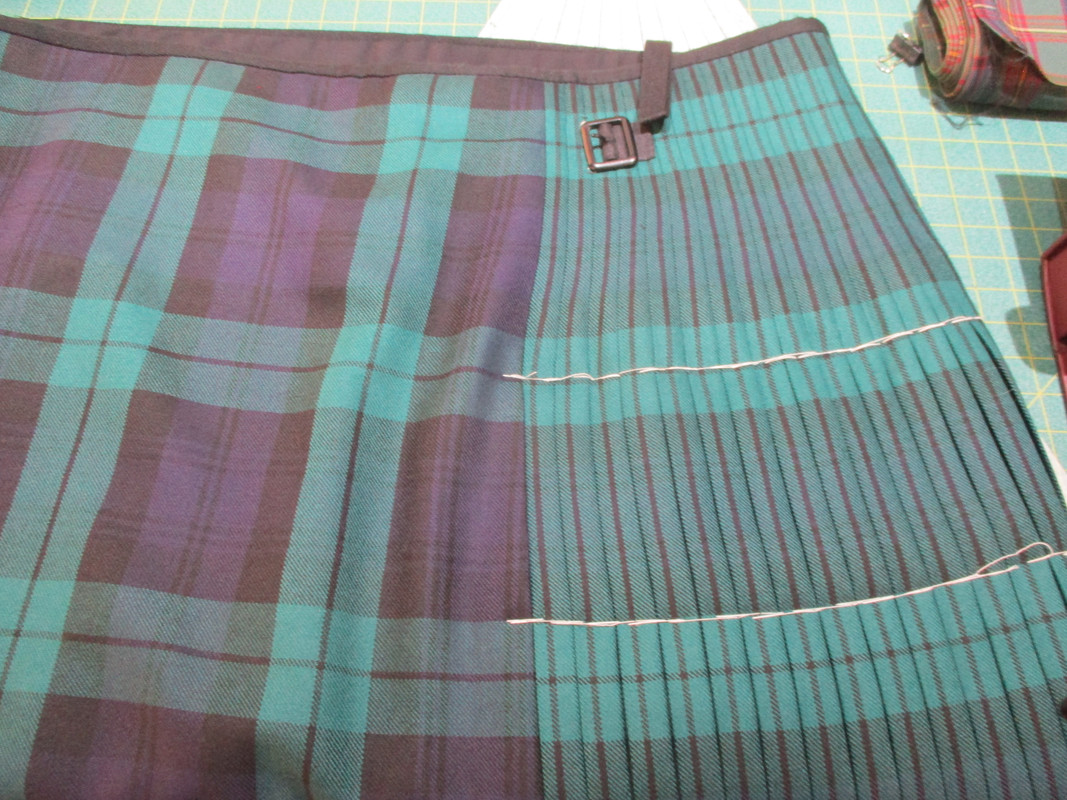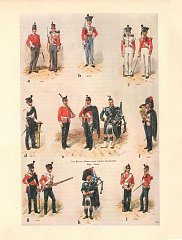|
-
20th October 20, 08:52 PM
#1
Pre-amalgamation Regimental kilts.
There is a discussion over on another forum which went south over the definition over terms.
So for this thread I will use the terms for the ways to fold fabric into pleats as given here. -

This is from page 7 of the box pleat supplement to TAoK.
OK, to the question. For those with actual first hand knowledge of pre-amalgamation military issue kilts.
From my understanding the Argyle & Sutherland Highlanders Other Ranks kilts were made from the Govt Sett #1 pleated in the Military Box Pleat style with the pleats to Stripe - the Black line within the Green band centered in each pleat.


And that the Black Watch (Royal Highland Regt.) Other Ranks kilts were made from Govt Set #1 pleated in the knife pleat style with the pleats to stripe - the center between the four black stipes in every other Blue band.
What some call "Knife pleat to the nothing"


Can anyone with knowledge of pre-amalgamation kilts confirm, deny, or correct this please.
I would rather not get into a discussion of the differences between Other Ranks kilts and Officers kilts.
And not about what fabric they were made of or any of the other topics we have covered ad-nauseum.
Last edited by Steve Ashton; 20th October 20 at 08:54 PM.
-
-
20th October 20, 09:13 PM
#2
Excuse my ignorance, but: does pre-amalgamation refer to Scottish units before the Scottish Division (1968), before the RRS (2004), or something else entirely?
-
-
20th October 20, 10:12 PM
#3
Let's call it the formation of the Royal Regt. of Scotland announced in 2004 and activated in 2007 as that is when a single Tartan and construction of a single style of kilt were adopted.
The current RRS kilt is Black Watch or Govt. Sett 2A Military box pleated to the single black line within the green band. The top banding was change from green to black and the straps and buckles changed to single prong and pre-holed straps.


-
-
21st October 20, 01:24 AM
#4
 Originally Posted by Steve Ashton

There is a discussion over on another forum which went south over the definition over terms.
So for this thread I will use the terms for the ways to fold fabric into pleats as given here. -

This is from page 7 of the box pleat supplement to TAoK.
OK, to the question. For those with actual first hand knowledge of pre-amalgamation military issue kilts.
From my understanding the Argyle & Sutherland Highlanders Other Ranks kilts were made from the Govt Sett #1 pleated in the Military Box Pleat style with the pleats to Stripe - the Black line within the Green band centered in each pleat.


And that the Black Watch (Royal Highland Regt.) Other Ranks kilts were made from Govt Set #1 pleated in the knife pleat style with the pleats to stripe - the center between the four black stipes in every other Blue band.
What some call "Knife pleat to the nothing"


Can anyone with knowledge of pre-amalgamation kilts confirm, deny, or correct this please.
I would rather not get into a discussion of the differences between Other Ranks kilts and Officers kilts.
And not about what fabric they were made of or any of the other topics we have covered ad-nauseum.
As far as I remember, both regiments pleated to the stripe, but the A&S kilts are box pleated and show more green in the back (to the black stripe on the green), while the BW knife pleated (until 1952 - barrel pleated) to show more blue in the back (alternating single black line and the double black lines on the blue).
In 1936 and up to 2006 , the standard pleatings for military kilts were: the Black Watch - 29 barrel then knife pleats, A&SH - 27-29 box pleats.
The RRS kilts are from Goverment #1A tartan (the lighter shade of Govt #1 ) as have been worn by A&SH officers (they called it "Sutherland").
Last edited by blackwatch70; 21st October 20 at 01:32 AM.
-
-
21st October 20, 07:00 AM
#5
 Originally Posted by blackwatch70

As far as I remember, both regiments pleated to the stripe, but the A&S kilts are box pleated and show more green in the back (to the black stripe on the green), while the BW knife pleated (until 1952 - barrel pleated) to show more blue in the back (alternating single black line and the double black lines on the blue
Actually, the Black Watch pleats are alternating between the pair of black lines and the blue section between the two pairs of black lines. I know this because I had to duplicate an original Black Watch regimental kilt while making kilts for the local pipe band. It can be seen in the photos as well.
Last edited by Arnot; 21st October 20 at 07:01 AM.
-
-
21st October 20, 08:27 AM
#6
 Originally Posted by Arnot

Actually, the Black Watch pleats are alternating between the pair of black lines and the blue section between the two pairs of black lines.
You are absolutely correct.
Thanks.
-
-
21st October 20, 04:00 PM
#7
As we know only five regiments retained their kilts after the 1809 de-kilting decision (the 42nd, 78th, 79th, 92nd, and 93rd) and only the 42nd and 92nd wore knife-pleated kilts.
Had the 1809 de-kilting had never happened there would have been twice as many kilted regiments in the 1809-1881 period. I wonder what their pleating would have been. I know that in the 1809-1881 period the 72nd, 74th, and 91st had pipers but I've not seen a list of the pipers' kilts' pleating for those regiments. I can't recall seeing images of pipers of the 71st, 73rd, or 75th in the 1809-1881 period.
That was the first round of amalgamations of course, in 1881, when regiments were paired off.
Then another round in the post-WWII era.
Last edited by OC Richard; 21st October 20 at 04:07 PM.
Proud Mountaineer from the Highlands of West Virginia; son of the Revolution and Civil War; first Europeans on the Guyandotte
-
-
22nd October 20, 01:52 AM
#8
 Originally Posted by OC Richard

I can't recall seeing images of pipers of the 71st, 73rd, or 75th in the 1809-1881 period.
Then another round in the post-WWII era.
71st Regiment of Foot didn't lose Highland status and definitely kept their pipers after 1809. 73rd and 75th officially lost the Highland status and pipers.


Last edited by blackwatch70; 22nd October 20 at 02:45 AM.
-
-
29th October 20, 07:59 AM
#9
 Originally Posted by blackwatch70

71st Regiment of Foot didn't lose Highland status and definitely kept their pipers after 1809. 73rd and 75th officially lost the Highland status and pipers.
found the article about 71st HLI pipers of 1830s in The Dispatch Journal.


Last edited by blackwatch70; 29th October 20 at 08:05 AM.
-
-
29th October 20, 12:48 PM
#10
No Broad Arrow on the labels? ...
The NATO number must puzzle the hay out of the Belgians.
Those ancient U Nialls from Donegal were a randy bunch.
-
 Posting Permissions
Posting Permissions
- You may not post new threads
- You may not post replies
- You may not post attachments
- You may not edit your posts
-
Forum Rules
|
|






















Bookmarks